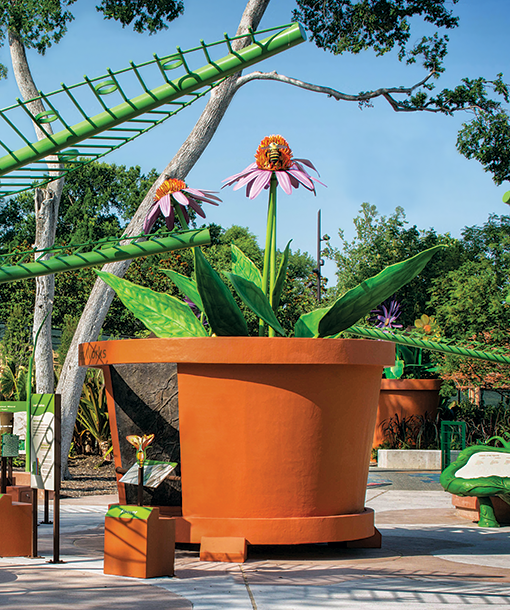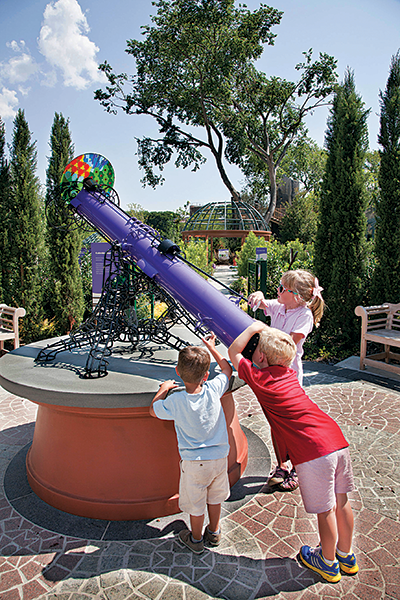
In the Plants are Alive gallery, large models demonstrate the inner working of plants and the functions of their different parts.
My husband and I fell in love with the Dallas Arboretum through years of snapping photos of our four kids tucked among tulips and propped on pumpkins. Soon they were old enough to frolic in the Toad Corners Fountain, peek into garden cottages, and run barefoot across velvety lawns amid concert music and fireflies. So when I learned about the Dallas Arboretum’s plan to open a world-class children’s garden, we scheduled a family visit to explore its new wonders first-hand.
The Dallas Arboretum swung open the gates of the $62-million Rory Meyers Children’s Adventure Garden in September, following 17 years of research on how to best inspire and educate local children. (Rory Meyers is a longtime Arboretum board member and former chair of its Education Committee.) “Please Touch” would be a good motto for the eight-acre, interactive garden designed specifically to address state and national education standards in life, earth, and environmental science. But academic designs don’t tell the whole story. Hugging the southeastern shoreline of tranquil White Rock Lake, the garden and its 17 learning galleries promise adventure, secrets, knowledge, mystery, and above all—wonder.
In the 200-seat Entry Plaza, we’re not only cooled and calmed by water bubbling from fountains and spraying from misters, but also amazed at how water weaves through the myriad creeks and pools of the lush gardens below. Our first stop is the Incredible Edible Garden. Sprawling cantaloupe and pumpkin vines greet us with round, ripe fruit. We inspect the banana herb (surprisingly, not a tree!) and learn that a banana is a “finger” that grows in a “hand,” or bunch. Bountiful broccoli, royal eggplant, and crimson peppers create an edible rainbow garden, reminding us that food doesn’t originate in a supermarket, but rather from plants, shrubs, trees, and vines. The garden’s produce varies seasonally to reflect current growing conditions.
The word “maze” on our map ignites excitement, and The Amazing Secret Garden does not disappoint. We weave through secret passageways lined with glossy-green holly shrubs to discover clues etched in silver swords, mist-breathing dragons, and hidden fairy gardens. Eleven-year-old Abby and six-year-old Andy compete on the dance chimes, while 13-year-old Ben prefers the periscope view.

In the Kaleidoscope gallery, visitors learn about the light, color and structure of the natural world, and explore how those elements influence art and architecture.
After the maze, we hike switchbacks tracking native Texas plants and animals to the 31,000-square-foot Texas Native Wetlands. Gurgling water offers vitality to this ecosystem, and we explore via boardwalks framed in native grasses. Perched in a secluded wildlife blind, eight-year-old Grace peers through binoculars at periwinkle dragonflies as they flit from reeds to lily pads. “Please touch miniature lily pads gently,” reads a sign next to a small raised pond. “Mom, did you see this? It says ‘please touch!’” she exclaims. We stroke the rubbery pad and learn how its strong roots anchor the plant, while its waxy surface keeps it afloat. The wind rustles through the grand oaks overhead and a rabbit scampers across our path—perks of a museum without walls.
Our next stop is the Pure Energy gallery, where we experiment with how wind, sun, and water transform into energy. We launch the air cannon, shoot water pistols, adjust dams on a river model, and angle solar panels to convert the sun’s energy into electricity, making pinwheels spin in the adjacent pond. Lizz “the Science Whizz” Klammer, the garden’s vice president of creativity and innovation, introduces herself and shows the kids how a closed circuit works by linking their hands around a plastic, foil-capped energy stick. Their eyes light up as the stick beeps and flashes. “As a science teacher, I’ve never seen anything, anywhere, like this garden,” she says. “Children play and don’t even know they’re learning—that’s the wonder of this place.”
The sun dips low in the sky as we arrive at the 9,100-square-foot, leaf-shaped Exploration Center. Inside, we’re immediately drawn to the five-foot-tall OmniGlobe, a high-tech spherical screen that depicts plate tectonics, climate change, and current weather patterns, and even morphs into the moon and planets. Marveling at the OmniGlobe’s display of Earth, Andy wonders aloud, “Does the Earth real-ly spin like that?” Meanwhile, Abby sits at a Smart Table, manipulating objects on a touch surface to solve a CSI science mystery, and Grace dips her hands in a display of loamy soil. The Children’s Adventure Garden updates the technology content in the Exploration Center seasonally—as it does in the 120 electronic display panels throughout the garden—making every visit a fresh experience.
It’s almost closing time as we climb a staircase inside a burly tree snag leading to the 240-foot-long Texas Skywalk. At the edge of the tree’s platform, we leap like fledgling baby birds into sturdy rope nets. For a split second, I’m flying, weightless, enveloped in the heady scent of sycamore. Descending through the canopy, our kids spy the giant potted flowers in the Plants Are Alive gallery. With so many learning galleries still to experience, I know we’ll return soon. But tomorrow morning brings another school day, and I’m certain, a fresh perspective on science.








